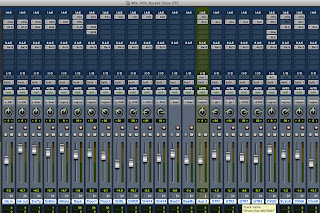I've a Takamine acoustic guitar, would
you ever go straight into desk and mic at the same time?
I almost never use the direct out of a semi
acoustic guitar. That’s not to say you shouldn’t though but I find it much
easier to get a decent sound with a well placed microphone. The sound from an
acoustic guitar is a sum of its parts, that is if you listen to one part, the
bridge, like the direct out does, then you aren’t getting the full sound.
If you are unsure of microphone technique
or are recording in a noisy environment then you can get some use out of it.
Otherwise make the microphone your predominant texture.
Where do you set the threshold on a
compressor? Many software compressors have adjustable threshold settings and
I've often wondered where is the right place.
Probably the best way to go about the
threshold is to set it to an extreme setting and then work back from there. I
normally set it so the compressor is measuring 3-6db of gain reduction. If you
slam the sound into the threshold then as you back it off you get a good idea
of what the sound is doing.
If you set the threshold of a compressor
high, with a ratio of about 4:1 and getting about 6db reduction, is the sound
the same as setting the threshold lower though with a ratio of 1:5:1 and
getting -6db.
That’s a no. With
the low ratio/low threshold combo, pretty much all of the sound is compressed,
even though it’s by a small amount. With the high ratio/high threshold combo
just the loudest parts are being compressed. The gain reduction amount might
look the same but it’s affecting the sound differently.
What Sound Card
should I use?
How long is a
piece of string? There are many sound card choices out there and there are many
that will do the job you need.
The main questions
you should answer before buying are:
How much can I
spend?
 |
| Avid sound cards/interfaces with Pro Tools bundles |
If you have more
money then obviously you can buy a better unit. Buy the best you can afford,
it’s the main way you will get signal to your software, don’t skimp!
How many inputs
will I need?
No need to get 32
inputs if you only need 2 and likewise no need to get 2 when you want to record
a drum kit!
Do I need
software?
You may already
have software. If not some sound cards come bundled with software. Either way
factor this into your budget.
What can my
computer handle?
If you have an old
slow computer then it will restrict everything from the number of tracks you
can play to the amount of effects and plug ins you can use. There’s no point in
spending €1000’s on a card if your computer is not up to it.
What microphone
do you recommend for an acoustic guitar?
 | |
| Typical acoustic microphone technique |
By and large
acoustic guitars are quiet and have a full frequency range. I’d avoid dynamic
mics like Shure SM58s, especially if you are going into a cheap preamp. The
Dynamic mics tend to be quiet and not recreate high frequencies that well.
Condenser mics are
somewhat more suited. Again check you budget and see what you can afford. SE
Electronics and Rode are good low budget starting points.
That’s it from me!
Thanks for reading, and don’t forget to check out the videos on my website.
Andy Knightley
info@krecording.com
















